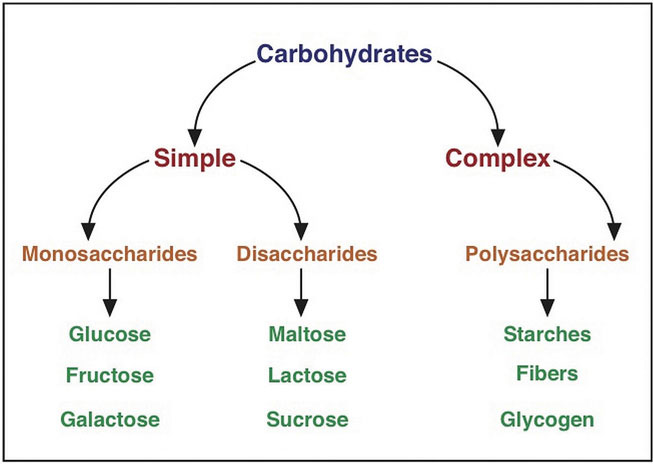5.1 Functions and Classification of Carbohydrates
Functions of Carbohydrate
Carbohydrates (CHO) are compounds composed of the elements carbon, hydrogen, and oxygen. This is where the abbreviation, CHO, comes from, carbon, hydrogen, oxygen. As discussed previously they are one of the three macronutrients that supply our bodies with energy and provide 4 kcals per gram. The primary function of carbohydrates is energy production. Carbohydrate is the fastest and most efficient way for the body to produce energy. Every cell in the human body uses carbohydrate for energy when it is available and some organs such as the brain, central nervous system, and red blood cells rely solely on carbohydrate for energy. The RDA for carbohydrates of 130 g/day for adults and children represents the minimum amount of carbohydrate required for brain function. Athletes or active individuals will likely need much more carbohydrate for optimal performance as carbohydrate is the primary fuel source for the muscles during moderate and intense physical activity. Later in this chapter you will have the opportunity to estimate your personalized carbohydrate recommendation based on your activity level.
Finally, carbohydrates are considered “protein sparing.” This means that because your body prefers to use carbohydrates for energy, when there are adequate amounts of carbohydrate available, protein (which also provides 4 kcals per gram) will be used to build and maintain lean muscle tissue. If carbohydrate intake is too low, the body will begin to break down muscle proteins to make up for the lack of carbohydrates. This can be detrimental for both athletic performance and fat loss.
Carbohydrate Classification
Carbohydrates are a group of organic compounds containing a ratio of one carbon atom to two hydrogen atoms to one oxygen atom. Basically, they are hydrated carbons. The word “carbo” means carbon and “hydrate” means water. Monosaccharides, the smallest unit of carbohydrate, have six carbon atoms, twelve hydrogen atoms, and six oxygen atoms. The chemical formula is written as C6H12O6. Synonymous with the term carbohydrate is the Greek word “saccharide,” which means sugar. The simplest unit of a carbohydrate is a monosaccharide. Carbohydrates are broadly classified into two subgroups, simple (“fast-releasing”) and complex (“slow-releasing”). Simple carbohydrates are further grouped into the monosaccharides and disaccharides. Complex carbohydrates are long chains of monosaccharides. Figure 5.1 shows how carbohydrates are classified.
Figure 5.1 Carbohydrate Classification

Media Attributions
- Carbohydrate Classification © The University of Hawaii is licensed under a CC BY (Attribution) license
